
Prelude to Offshore Drilling Not a Blast for All (Op-Ed)
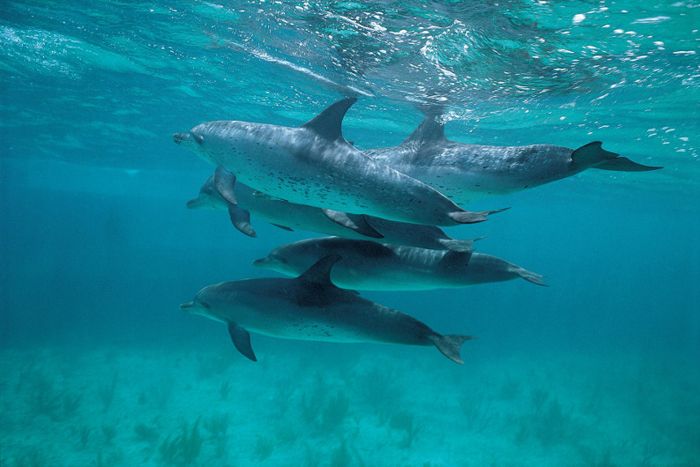
Andrew Menaquale is an energy analyst with Oceana. He contributed this article to Live Science's Expert Voices: Op-Ed & Insights.
Recently, the administration of U.S. President Barack Obama decided to move forward with preliminary steps for offshore drilling in the Atlantic Ocean, an area where the practice has not been allowed for more than 30 years. Oil and gas companies are currently applying for permits to conduct seismic airgun blasting in waters from Delaware to Florida, the first in a series of steps that would lead to drilling — steps that put more than just marine mammals at unnecessary risk.
In July, the U.S. Bureau of Ocean Energy Management (BOEM) decided to move ahead with plans to allow airgun blasting off the U.S. East Coast. The practice uses seismic airguns to generate incredibly loud blasts of compressed air that reveal oil and gas located miles beneath the ocean floor. Offshore drilling companies will use multiple boats to conduct the testing day and night, and much of the testing information will be hidden from the public. That means extensive seismic surveys will take place without public knowledge, threatening marine life and coastal economies.
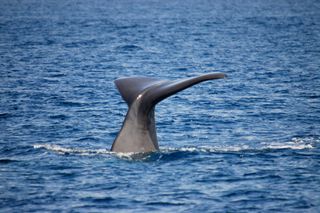
Risks to marine life
When searching for oil and gas, seismic airguns repeat blasts every ten to twelve seconds — for days to weeks at a time. The practice disturbs marine mammals and other marine life, including commercially valuable fish. A study on cod and haddock done in Canada found disruptions from seismic to decrease catch rates by 40 to 80 percent surrounding the use of just one airgun array.
The U.S. government has already estimated that current proposals would injure or possibly kill over 138,000 marine mammals, and could disturb the vital behaviors of another 13.5 million in BOEM’s environmental impact statement for the area. The dynamite-like blasts can affect marine mammals by scaring animals away from their habitats and disrupting mating and feeding. They can also cause temporary and permanent hearing loss, beach strandings , and possible death of these animals.
Apart from putting many endangered species at risk, including the critically endangered North Atlantic Right Whale, airgun blasts could also damage already vulnerable fish populations by disrupting adult fish, and, at a close range, kill fish eggs and larvae.
Sign up for the Live Science daily newsletter now
Get the world’s most fascinating discoveries delivered straight to your inbox.
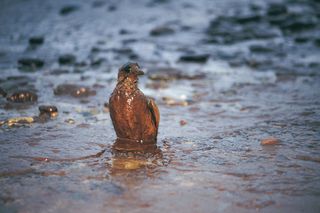
Risks to coastal communities
Seismic airgun blasting, and ultimately offshore drilling, are cause for concern for many local communities along the Atlantic. Airgun blasting may threaten where, and even if, local fishermen will be able to make their catches due to effects on fish. And, the disruption, injury and possible death of marine mammals will affect a significant portion of the tourism industry that relies on these creatures, such as dolphin and whale watching.
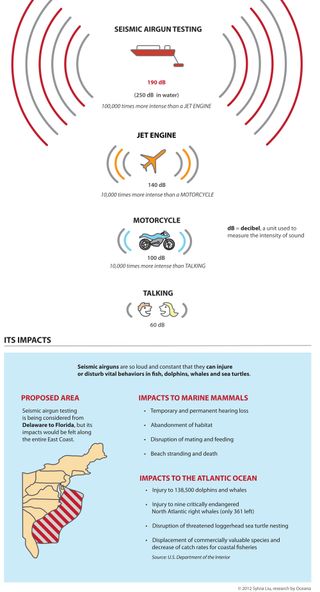
Allowing seismic blasting also opens the door for offshore drilling, putting the entire East Coast at risk of an oil-spill disaster, as has happened in the Gulf of Mexico. There have been several major offshore drilling accidents in the Gulf, including the BP oil spill disaster in 2010, from which communities still have not recovered, and daily, "minor" leaks coming from oil rigs across that region — not to mention the numerous accidents involved in transporting oil.
With popular seaside communities dotting the East Coast, the area is home to at least half a million people who depend on a healthy ocean ecosystem for their livelihood — people who would live under the threat of an almost inevitable oil spill that would jeopardize their tourism dollars, fish stocks and public health. And, the burning of the oil and gas would exacerbate the effects of climate change, damaging communities and ecosystems through sea-level rise, ocean acidification and loss of fish through migration. [Poll: 51 Percent of Americans Oppose Offshore Oil Drilling ]
Many local communities and public officials have already come out against seismic blasting along the Atlantic. More than 20 coastal towns, from New Jersey to Florida, have passed resolutions opposing seismic blasting to search for oil and gas deposits off their shores. Since the beginning of 2013, 64 bipartisan and bicameral members of the U.S. Congress have signed on to 11 letters to President Obama calling on his administration to refrain from using the technology.
Other public officials have also come out against offshore drilling in the area, including Virginia's lieutenant governor, Ralph Northam, who is concerned about the effects offshore drilling could have on the NASA Wallops Flight Facility, military exercises, tourism, and local aquaculture businesses.
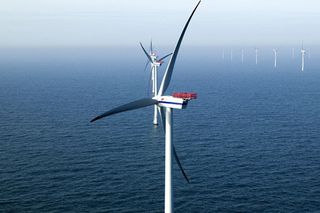
There are alternatives
There are energy alternatives that would avoid those effects — specifically, offshore wind, which could be done in these same offshore areas and would be much less harmful to the marine environment.
BOEM recently leased 80,000 acres off the coast of Maryland for offshore wind-energy development. With potential leases going up for bid later this year in Massachusetts and New Jersey, there could be over a million acres of area for offshore wind-energy development, joining efforts that have already begun in other states, like Delaware and Virginia, and an area shared between Massachusetts and Rhode Island.

Offshore wind provides clean, renewable energy to coastal areas near where it is harnessed, and without the risk of seismic airgun blasting or a catastrophic oil spill.
Yet BOEM is already reviewing applications for seismic airgun blasting. The next steps will be site-specific analyses of the application areas, during which evaluators will consider emerging scientific data and company compliance with current legal protections to decide whether or not a permit will be granted.
With the current schedule, airguns could be in the water as early as the beginning of 2015.
Follow all of the Expert Voices issues and debates — and become part of the discussion — on Facebook, Twitter and Google+. The views expressed are those of the author and do not necessarily reflect the views of the publisher. This version of the article was originally published on Live Science.












